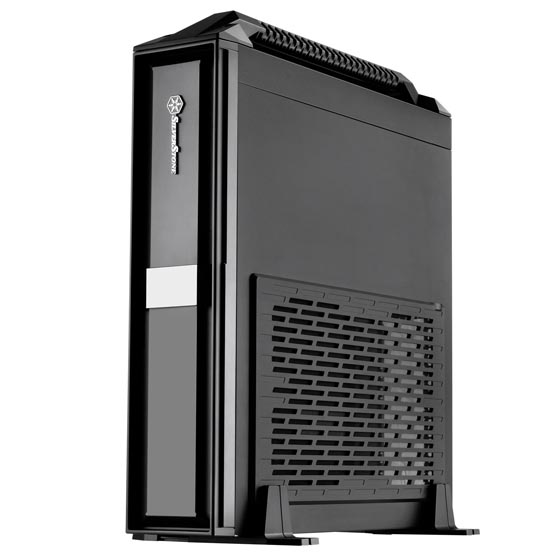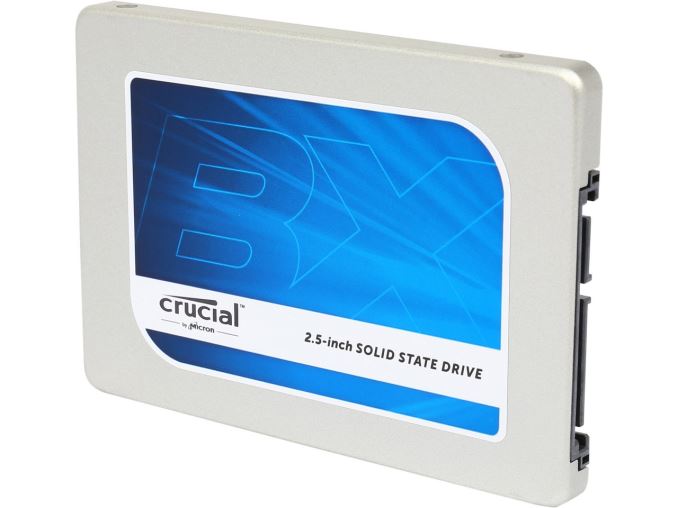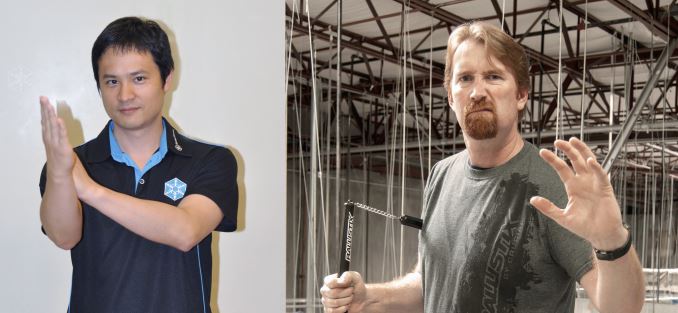Build-A-Rig Round 2: SilverStone and Crucial Interviews and $800 Back-To-School PCs
by Ian Cutress on October 13, 2015 8:00 AM EST- Posted in
- Build-A-Rig
- Crucial
- SilverStone
- Interview

Last quarter we introduced our new Build-A-Rig project. At a high level, we ask two or three companies in the PC industry each round to configure a system to a budget. Then, with our partners Newegg, we build and test each system in glorious battle, along with interviewing the participants about how they approach the industry. Regardless of the winner, all the systems built are given away to our lucky readers. Imagine Top Gear UK’s ‘Star In A Reasonably Priced Car’, but instead of celebrities racing around a track, we let the configured PCs do the racing where both style and performance count. In this round, given the timing as school is starting, we chose SilverStone and Crucial with a budget of $800 for a back-to-school system.
The Rules
When we approach the companies to configure within a budget, there are certain rules they have to follow in order to be fair:
- All components must be available at Newegg.com at the time of selection (so no pre-choosing unreleased parts)
- No combo deals will be considered
- No mail-in-rebates will be considered
- Components must be compatible
- There will be sometimes be a price difference between configuration and giveaway, so a 3% leeway is given on the overall build budget if prices change
- There is no compulsion to use the hardware of who you’re up against
- Each round, we will let the companies competing know who they’re up against, but not the build until it is published on AnandTech
- Each company must agree to an interview on their build
This means that whatever the budget, each participant might end up deciding a different sized build, or a different concept (Steam box or hardcore gaming). As we have found out, it also means that each participant has a stringent choice – either select their best components and perhaps have to reduce the rest of the build to fit the budget, or choose the best performance and only their own mid-or-low range hardware.
Of course, for each build by the companies that actually make the hardware, we also want our readers to chime in with their own thoughts. What would you do differently?
It should be noted that for Round 2, companies were asked to supply builds before September 25th. This makes sourcing Skylake parts somewhat troublesome.
Previous Build-A-Rig Rounds
Here are links to our Build-A-Rig Introduction and previous challengers:
Round 1: $1500 Single Monitor Gaming PC
Corsair's 'The Accelerator', as chosen by Dustin Sklavos (Interview, Breakdown, Build Log, Results)
Zotac's 'Hey Good Lookin', as chosen by Chinny Chuang (Interview, Breakdown, Build Log, Results)
The Contest
This is Round 2 of our glorious project, and given the September-October timeframe, we asked our contestants to produce a specification list for a system that costs $800, with a focus on back-to-school operation. For the parts list, this means the following:
- Processor (CPU)
- Motherboard
- Graphics Card(s) (GPU)
- Memory (DRAM)
- Storage (SSD or HDD, or both)
- Power Supply (PSU)
- Chassis (Case)
- CPU Cooling
- Operating System
- Extras
Obviously there are more elements to a full system than this, particularly when discussing the monitor, keyboard, mouse, mouse mat and other utilities, although we will reserve that choice of rounds with a bigger budget to play with. Something like a monitor is arguably a 10-year lifecycle purchase, whereas keyboards and/or mice are either upgrades from something very simple or replacements when breaks occur.
Because we only specified $800, this opens up how both SilverStone and Crucial have interpreted what this means and we get very different builds focusing on performance and style.
The Participants – Tony Ou from SilverStone Technology
Despite the look of youth, Tony is an industry veteran. We first crossed paths back at Computex 2011, my first major industry event, and I was instantly struck by Tony’s own knowledge about his own product lines and how they fit into the industry as a whole. Every case has a story to tell, and I remember the discussions we had around the push for a Thunderbolt-based graphics dock, as well as some words about the difficulties of producing such a device. Tony is very much into his gaming PC cases as well as the small form factor builds, echoing the sentiment of his employer.
The Participants – Jeremy Mortenson from Crucial (Micron)
The best way to think of Crucial is a brand of Micron, whereby Crucial sells more to end-users and Micron focuses on DRAM IC production, NAND, and business customers. Jeremy covers both, and like Tony he has been in this industry a good number of years and flexes that knowledge to the fullest. This leads to some interesting conversations around the $800 build here, as Jeremy has approached the build somewhat differently for the cooling and OS choice than I suspect 95% of our potential participants would have done. He's also an avid gamer, with a collection stretching back over 20 years of important industry titles.
Up Next: Interview with Tony Ou (SilverStone Technology)













93 Comments
View All Comments
fokka - Tuesday, October 13, 2015 - link
i'm much more torn between those two systems than i was in the first round (accelerator ftw!), but i guess that's not a bad thing.on the milo i like the gtx 960, the ram and the bx100, but i think it puts too much money on the slow 2.5" hdd, the psu and maybe even the case and cooler.
the pentium might not be a bad choice in combination with the 960 and it saves a good deal of money, but in the end i would have a better feeling having an i3 in my system.
in that sense the crucial rig makes a great start with the i3, but then it falls short in the graphics department, just to save 20 bucks.
the larger ssd and the faster hdd are very nice to have and i have to say that i like the thermaltake case more than the silverstone, but i think the psu is oversized and i would just go with windows 10 and get rid of the dvd drive.
i like that crucial saves money by leaving the after market cpu cooler, but i would have liked to see the money go to a gtx 960, instead of an optical drive.
overall i have to say that the crucial build is more appealing to me, with the one substantial flaw that it's slightly lacking in the graphics department. without the dvd drive, but with a 960 it would be a clearer winner for me.
xthetenth - Tuesday, October 13, 2015 - link
Both those cards are probably going to have the same life span to be honest, the 2 GB ones are already starting to have issues with slow frames and low minimum framerates. If either had gone with more VRAM, I'd side with that one in a heartbeat. Past that, the 950 is close enough to the 960 it's still pretty reasonable.fokka - Tuesday, October 13, 2015 - link
sure, it won't be a night and day difference, i'm just saying for only 20 bucks more i would have a better feeling with the 960, plus it would be on par with the competing system.Samus - Wednesday, October 14, 2015 - link
Realistically the G3258 and GTX960 will last a year or so of AAA gaming at mid-1080P, then as Tony said, given $400 a year from now to upgrade, he'd put $150 toward a CPU and $250 toward a GPU.His build has a 120GB SSD and a 1TB HDD which if you sacrificed for a 500GB HDD, you could get a 240GB SSD with the savings since the MX200 250GB is $80.
That would be the only adjustment I'd make to his build, it is otherwise perfect.
rrinker - Tuesday, October 13, 2015 - link
For the purposes of a back to school system, I don't see the optical drive as a waste of money. I'm sure you could find a way to get a DVD or CD to a USB stick if you absolutely had to, but having the drive handy makes it much more convenient. Some things, especially in education, are still strictly on optical media.To me, the more capable processor and especially the larger SSD capacity make for a more suitable system for the purpose, especially since it came out cheaper. Plus the somewhat overkill power supply allows upgrading that video card down the road when school is over and it's time to game.
fokka - Tuesday, October 13, 2015 - link
you got a point with the dvd drive, but personally i'd still prefer a more capable GPU instead of it. you can always get a drive in a pinch should you really need it, but you won't upgrade your gpu so willy nilly on a new computer.i still think a 600w psu is overkill though on a 800$ computer running a 950 and an i3, even if you want to upgrade your gpu somewhere down the road. but i admit that i'm generally more conservative with my psu estimates.
Frenetic Pony - Wednesday, October 14, 2015 - link
I haven't used an optical drive in years and have never needed to in years. Graduated college last summer and never had a use for it, the things are a waste of space and money to me.janisgomez456465 - Wednesday, October 14, 2015 - link
vantages and disadvantage.
coconutboy - Thursday, October 15, 2015 - link
Regarding the $600 psu in Jeremy's build, I think you've focused too heavily on the wattage instead of the price/quality ratio. That 600w Thermaltake psu is ~$15 cheaper than the 450w Silverstone unit in Tony's build. Compare the reviews of the two and you'll see the end result. The cheaper "600w" has crap reviews, while the better quality 450w looks solid.Even though most people these days go overboard in buying a psu that's far in excess of what they actually need, that's still one of the better pc trends over the past decade versus the 90s/early 2k when most power supplies were poorly built with a race-to-the-bottom mentality.
janisgomez456465 - Wednesday, October 14, 2015 - link
my parents inlaw just got an awesome 12 month old Lexus just by parttime work from a computer. you could look here